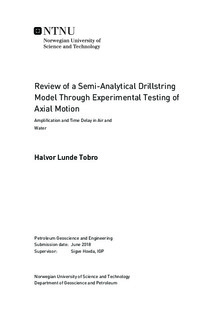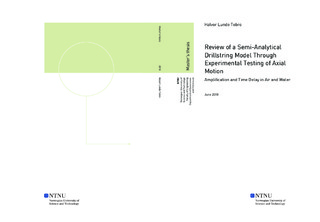| dc.description.abstract | Prediction of downhole movement is key to foresee surge and swab fluctuations, and the ability to maintain pressure within the boundaries of the operational window. Especially during connections, the movement of the structure is inflicted on the drillstring, as no heave compensation exists when the drillstring is set in slips. A lumped element model developed in Hovda (2017) is presented, with the ambition of predicting downhole movement as a function of only topside movement and a transfer function.
The objective of the experiments was to gather empirical data on the relationship between frequency, and both amplification and time delay. This was done by recording the behavior of harmonic oscillations by a drillstring in both air and water. The model was tested in a 66 m deep well, with an inner diameter of 68.9 mm. The drillstring consisted of 60 m of pipes with an outer diameter equal to 21.3 mm, and one joint of 6 m length with an outer diameter of 38.0 mm, to resemble a bottom hole assembly (BHA). The drillstring was oscillated by a motor, inflicting rotational motion on an offset-disc with an off-centered connection to the drillstring, above the well. Experiment frequencies ranged from 0.25 to 12.75 Hz, in increments of 0.25 Hz. It was decided not to increase frequency any further, to maintain HSE. The first resonant frequencies were estimated to 18.75 and 18.15 Hz for air and water respectively. Movement was monitored by two positional sensors on the drillstring. One directly beneath the motor, and one at the bottom of the drillstring. Initial experiments were preformed with an air-filled well. After functionality of the setup was confirmed, and sufficient data acquisition of the behaviour in air, the well was filled with water. Experiments were repeated with the new well fluid, for comparison of the difference made by changing fluid.
The obtained results were compared to the predictions first made in Tobro (2017), to determine the solidity of the model. Results proves that the model is capable of predicting amplification within a range from approximately 6 to 11.75 Hz. For frequencies below 5.25 Hz, measurements yielded an amplification of less than one in both fluids. According to model predictions, this should not occur for any frequency with low-viscous fluids as air and water. This is attributed to friction and stick-slip, influencing both amplification and delay. In experiments with frequencies ranging from 5.5 to 11.75 Hz, predictions of amplification best correspond with measurements in both fluids. At 6 and 11.75 Hz, amplification in air was predicted to 1.141 and 1.808, while measurements showed 1.114 and 1.812. In water, the predicted amplification at 6 and 11.5 Hz was 1.151 and 1.841, and the measured amplification 1.125 and 1.804. Above 11.75 Hz, an unexpected drop in amplification is seen. The cause of this drop is believed to be caused by effects outside the scope of the model, and is further discussed throughout the thesis.
A time delay was measured in experiments of both fluids, but not predicted by the model. At experiment frequencies below 6 Hz this delay is relatively large, at more than 10 ms, which is also attributed to friction and stick-slip. For the remainder of experiment frequencies, the time delay was found to be approximately constant at 4ms. The accuracy of that number is uncertain, as it is a small number and coincides with the sampling rate of experiment setup. Friction is likely still present at frequencies above 6 Hz, and its influence could very well cause such a small delay.
A sensitivity analysis was also performed, as an effort to identify areas of improvement in the model. Results of the sensitivity analysis showed fluid forces had to be increased significantly to match simulations to the measured results. Particularly matching results by alteration of Basset forces proved impossible, as matching delay set amplification further off. This implies that exterior factors, unaccounted for by the model, bear more significance, and that some assumptions of the fluid model, such as considering the drillstring an infinite plate, should be revisited. | |

